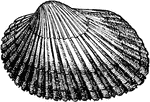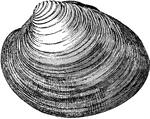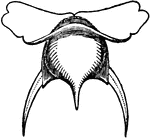
Foraminifera
The Foraminifera, ("Hole Bearers") or forams for short, are a large group of amoeboid protists…
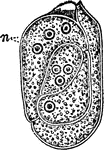
Young Imperforata
An illustration of a young imperforata with shell dissolved and protoplasm so as to show the seven nuclei.
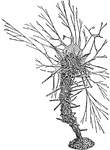
Haliphysena Tumanvitzii
Haliphysena Tumanvitzii; living specimen showing the wineglass-shaped shell built up of sand-grains…

Sea Urchin
Sea urchins are small, globular, spiny sea creatures, composing most of class Echinoidea. They are found…
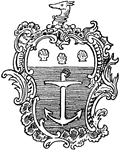
Rocaille Coquille
"Rocaille coquille, book-plate ornamentation in varying forms of the scallop-shell upon rockwork." -Whitney,…
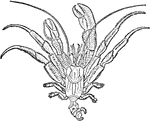
Hermit Crab
Hermit crabs are decapod crustaceans of the superfamily Paguroidea. They are not closely related to…

Early Stages of Balanus
An illustration showing the early stages of balanus: A, nauplis (larva); e, Eye; B, Cypris-larva with…

Sarinda
"Sarinda. A Hindu viol, which has a body made of a single wooden block, elliptical in general contour,…

Shell Work
"Shell-work, Hôtel Cluny, Paris. In decorative design, especially carved or modeled, a motive…

Shell-Bark Hickory
It is a slow-growing long-lived tree, hard to transplant because of its long taproot, and subject to…
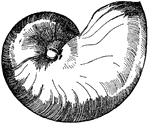
Nautilus Shell
The Nautilus Shell is a marine creature, it is shown in its natural form. It was usually placed on feet…

Exterior Scallop Shell
The Exterior Scallop Shell was used as a water basin in the form of a shallow dish and as a decorative…
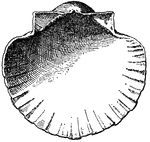
Interior Scallop Shell
The Interior Scallop Shell was used as a water basin in the form of a shallow dish and as a decorative…
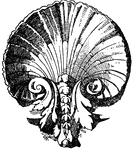
Scallop Design Shell
This Scallop Design Shell was a Louis XVI style. It was used on the lower end of a panel.

Scallop Design Shell
This Scallop Design Shell was used as a decoration of a niche. A design commonly used during the Late…

Female Nautilus without Shell
An illustration of a female nautilus without the shell. "m, The dorsal "hood" formed by the enlargement…

Female Nautilus without Shell
An illustration of a female nautilus without the shell. "c, points to the concave margin of the mantle-skirt…
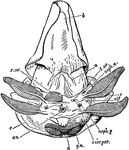
Female Nautilus without Shell
An illustration of the postero-ventral view female nautilus without the shell. "a, Muscular band passing…
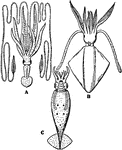
Cephalopod
The cephalopods are the mollusk class Cephalopoda characterized by bilateral body symmetry, a prominent…
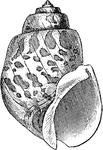
Ivory Shell
The Ivory Shell (Eburna spirata) is a gastropod mollusk in the Buccinidae family of true whelks.

Urchin Fossil
A fossil of Echinothuria floris, a species of sea urchin "having the plates of the shell overlapping…

A Foraminiferal Shell
A foraminiferal shell or the Miliola type. Note that each new chamber covers all preceding ones. Important…

Fusulina Cylindrica
Fusulina cylindrica, a typical foraminiferal shell forming rocks in the later Paleozoic. A single shell…
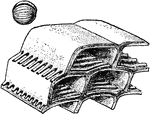
Schwagerina Verbecki
A typical foraminiferal shell shaped more or less like a football in form (diagrammatical view).
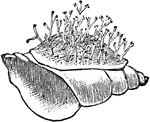
Hydrozoa Encrusting a Small Shell
Hydrozoa (hydrozoans) are a taxonomic class of very small, predatory animals which can be solitary or…

Brachiopod
A Paleozoic brachiopod shell partly broken to show the internal spiral arm-supports. Mississippian limestones.…

Common Clione
A modern shell-less pteropod. Called the common clione, naked sea butterfly, and Clione limacina.
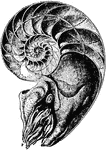
Chambered Nautilus
The modern Pearly Nautilus; the animal occupies the living chamber of the sectioned shell.

Cuttlebone
Cuttlefish "bone" or internal shell. The fine point at the base structure represents the guard of the…

Ammonite
Ammonite, side view. Where the shell has been partly worn away near the aperture, the complex "suture…
Cephalopod
A simple straight-shelled cephalopod. Where the shell has been removed, the straight sutures are shown.
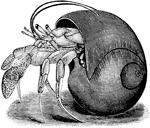
Hermit Crab
This hermit crab (Eupagurus bernhardus) is in the shell of the northern moon snail (Lunatia heros).
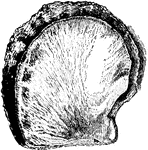
Oyster Shell
An illustration of a oyster shell. The common name oyster is used for a number of different groups of…
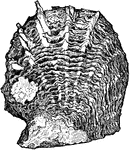
Oyster Shell
An illustration of a oyster shell. The common name oyster is used for a number of different groups of…

Oyster Shell
An illustration of a oyster shell. The common name oyster is used for a number of different groups of…

Shell of the Tulip Snail
The shell of the Tulip Snail (Fasciolaria tulipa), a gastropod in the Fasciolariidae family of tulips…

Cypris
Cypris, a modern ostracod. Female before sexual maturity, right valve of shell removed to show internal…
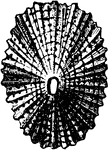
Shell of Keyhole Limpet
The shell of Fissurella listeri, a species of keyhole limpet, a freshwater snail.
Pelecypod
Shells of a pelecypod found in the elevated sand beds of northeastern New England, New Brunswick, etc.…
Spindle Shell
"Spindle-shell (Fusus colus). Fusus: a genus of gastropodus mollusks having a fusiform shell with a…

Right Valve of Galatea Bivalve
Galatea reclusa is a species of bivalve mollusk in the Donacidae family of bean clams (wedge shells).

Dorsal View of Gastrochaena
"Dorsal View of Gastrochaena. The ventral view shows the dried mantle with pedal perforation." -Whitney,…

Ventral View of Gastrochaena
"Ventral View of Gastrochaena. The ventral view shows the dried mantle with pedal perforation." -Whitney,…

Lateral View of Gastrochaena
"Lateral View of Gastrochaena. The ventral view shows the dried mantle with pedal perforation." -Whitney,…
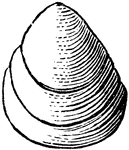
Lingula Prima
The Lingula prima is a little bivalve shell belonging at the bottom of the class Brachiopoda. The inarticulate…

Lingula Antigua
The Lingula antigua is a little bivalve shell belonging at the bottom of the class Brachiopoda. The…
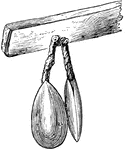
Modern Lingula
Lingula is a genus of brachiopods within the class Lingulata. Lingula is among the few brachiopods surviving…
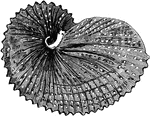
Paper Nautilus Octopuses
The argonauts (genus Argonauta, the only extant genus in the Argonautidae family) are a group of pelagic…
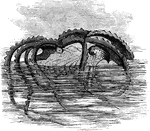
Paper Nautilus Octopuses
The argonauts (genus Argonauta, the only extant genus in the Argonautidae family) are a group of pelagic…





